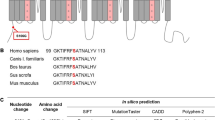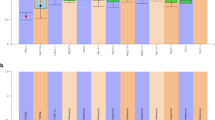Abstract
Sudden arrhythmic death syndrome (SADS) in young individuals is a devastating and tragic event often caused by an undiagnosed inherited cardiac disease. Although post-mortem genetic testing represents a promising tool to elucidate potential disease-causing mechanisms in such autopsy-negative death cases, a variant interpretation is still challenging, and functional consequences of identified sequence alterations often remain unclear. Recently, we have identified a novel heterozygous missense variant (N1774H) in the Nav1.5 channel-encoding gene SCN5A in a 19-year-old female SADS victim. The aim of this study was to perform a co-segregation analysis in family members of the index case and to evaluate the functional consequences of this SCN5A variant. Functional characterization of the SCN5A N1774H variant was performed using patch-clamp techniques in TsA-201 cell line transiently expressing either wild-type or variant Nav1.5 channels. Electrophysiological analyses revealed that variant Nav1.5 channels show a loss-of-function in the peak current densities, but an increased late current compared to the wild-type channels, which could lead to both, loss- and gain-of-function respectively. Furthermore, clinical assessment and genetic testing of the relatives of the index case showed that all N1774H mutation carriers have prolonged QT intervals. The identification of several genotype and phenotype positive family members and the functional implication of the SCN5A N1774H variant support the evidence of the in silico predicted pathogenicity of the here reported sequence alteration.






Similar content being viewed by others
Explore related subjects
Discover the latest articles and news from researchers in related subjects, suggested using machine learning.References
Ackerman MJ, Priori SG, Willems S, Berul C, Brugada R, Calkins H, Camm AJ, Ellinor PT, Gollob M, Hamilton R, Hershberger RE, Judge DP, Le Marec H, McKenna WJ, Schulze-Bahr E, Semsarian C, Towbin JA, Watkins H, Wilde A, Wolpert C, Zipes DP, Heart Rhythm S, European Heart Rhythm A (2011) HRS/EHRA expert consensus statement on the state of genetic testing for the channelopathies and cardiomyopathies: this document was developed as a partnership between the Heart Rhythm Society (HRS) and the European Heart Rhythm Association (EHRA). Europace 13(8):1077–1109. https://doi.org/10.1093/europace/eur245
Basso C, Aguilera B, Banner J, Cohle S, d'Amati G, de Gouveia RH, di Gioia C, Fabre A, Gallagher PJ, Leone O, Lucena J, Mitrofanova L, Molina P, Parsons S, Rizzo S, Sheppard MN, Mier MPS, Kim Suvarna S, Thiene G, van der Wal A, Vink A, Michaud K, Association for European Cardiovascular P (2017) Guidelines for autopsy investigation of sudden cardiac death: 2017 update from the Association for European Cardiovascular Pathology. Virchows Arch 471(6):691–705. https://doi.org/10.1007/s00428-017-2221-0
Cerrone M, Priori SG (2011) Genetics of sudden death: focus on inherited channelopathies. Eur Heart J 32(17):2109–2118. https://doi.org/10.1093/eurheartj/ehr082
Narula N, Tester DJ, Paulmichl A, Maleszewski JJ, Ackerman MJ (2014) Post-mortem whole exome sequencing with gene-specific analysis for autopsy-negative sudden unexplained death in the young: a case series. Pediatr Cardiol 36(4):768–778. https://doi.org/10.1007/s00246-014-1082-4
Hertz CL, Christiansen SL, Ferrero-Miliani L, Fordyce SL, Dahl M, Holst AG, Ottesen GL, Frank-Hansen R, Bundgaard H, Morling N (2015) Next-generation sequencing of 34 genes in sudden unexplained death victims in forensics and in patients with channelopathic cardiac diseases. Int J Legal Med 129(4):793–800. https://doi.org/10.1007/s00414-014-1105-y
Anderson JH, Tester DJ, Melissa L, Ackerman MJ (2016) Whole-exome molecular autopsy after exertion-related sudden unexplained death in the young. Circ Cardiovasc Genet 9(3):260–265. https://doi.org/10.1161/CIRCGENETICS.115.001370
Bagnall RD, Weintraub RG, Ingles J, Duflou J, Yeates L, Lam L, Davis AM, Thompson T, Connell V, Wallace J, Naylor C, Crawford J, Love DR, Hallam L, White J, Lawrence C, Lynch M, Morgan N, James P, du Sart D, Puranik R, Langlois N, Vohra J, Winship I, Atherton J, McGaughran J, Skinner JR, Semsarian C (2016) A prospective study of sudden cardiac death among children and young adults. N Engl J Med 374(25):2441–2452. https://doi.org/10.1056/NEJMoa1510687
Christiansen SL, Hertz CL, Ferrero-Miliani L, Dahl M, Weeke PE, Camp L, Ottesen GL, Frank-Hansen R, Bundgaard H, Morling N (2016) Genetic investigation of 100 heart genes in sudden unexplained death victims in a forensic setting. Eur J Hum Genet 24(12):1797–1802. https://doi.org/10.1038/ejhg.2016.118
Lahrouchi N, Raju H, Lodder EM, Papatheodorou E, Ware JS, Papadakis M, Tadros R, Cole D, Skinner JR, Crawford J, Love DR, Pua CJ, Soh BY, Bhalshankar JD, Govind R, Tfelt-Hansen J, Winkel BG, van der Werf C, Wijeyeratne YD, Mellor G, Till J, Cohen MC, Tome-Esteban M, Sharma S, Wilde AAM, Cook SA, Bezzina CR, Sheppard MN, Behr ER (2017) Utility of post-mortem genetic testing in cases of sudden arrhythmic death syndrome. J Am Coll Cardiol 69(17):2134–2145. https://doi.org/10.1016/j.jacc.2017.02.046
Neubauer J, Lecca MR, Russo G, Bartsch C, Medeiros-Domingo A, Berger W, Haas C (2018) Exome analysis in 34 sudden unexplained death (SUD) victims mainly identified variants in channelopathy-associated genes. Int J Legal Med 132(4):1057–1065. https://doi.org/10.1007/s00414-018-1775-y
Shanks GW, Tester DJ, Ackerman JP, Simpson MA, Behr ER, White SM, Ackerman MJ (2018) Importance of variant interpretation in whole-exome molecular autopsy: population-based case series. Circulation 137(25):2705–2715. https://doi.org/10.1161/CIRCULATIONAHA.117.031053
Ackerman JP, Bartos DC, Kapplinger JD, Tester DJ, Delisle BP, Ackerman MJ (2016) The promise and peril of precision medicine: phenotyping still matters most. Mayo Clin Proc. https://doi.org/10.1016/j.mayocp.2016.08.008
Richards S, Aziz N, Bale S, Bick D, Das S, Gastier-Foster J, Grody WW, Hegde M, Lyon E, Spector E, Voelkerding K, Rehm HL, Committee ALQA (2015) Standards and guidelines for the interpretation of sequence variants: a joint consensus recommendation of the American College of Medical Genetics and Genomics and the Association for Molecular Pathology. Genet Med 17(5):405–424. https://doi.org/10.1038/gim.2015.30
Neubauer J, Haas C, Bartsch C, Medeiros-Domingo A, Berger W (2016) Post-mortem whole-exome sequencing (WES) with a focus on cardiac disease-associated genes in five young sudden unexplained death (SUD) cases. Int J Legal Med 130(4):1011–1021. https://doi.org/10.1007/s00414-016-1317-4
Gui J, Wang T, Trump D, Zimmer T, Lei M (2010) Mutation-specific effects of polymorphism H558R in SCN5A-related sick sinus syndrome. J Cardiovasc Electrophysiol 21(5):564–573. https://doi.org/10.1111/j.1540-8167.2010.01762.x
Zareba W, Sattari MN, Rosero S, Couderc JP, Moss AJ (2001) Altered atrial, atrioventricular, and ventricular conduction in patients with the long QT syndrome caused by the ΔKPQ SCN5A sodium channel gene mutation. Am J Cardiol 88
Clancy CE, Tateyama M, Liu H, Wehrens XH, Kass RS (2003) Non-equilibrium gating in cardiac Na+ channels: an original mechanism of arrhythmia. Circulation 107(17):2233–2237. https://doi.org/10.1161/01.CIR.0000069273.51375.BD
Remme CA, Verkerk AO, Nuyens D, van Ginneken AC, van Brunschot S, Belterman CN, Wilders R, van Roon MA, Tan HL, Wilde AA, Carmeliet P, de Bakker JM, Veldkamp MW, Bezzina CR (2006) Overlap syndrome of cardiac sodium channel disease in mice carrying the equivalent mutation of human SCN5A-1795insD. Circulation 114(24):2584–2594. https://doi.org/10.1161/CIRCULATIONAHA.106.653949
Makita N (2009) Phenotypic overlap of cardiac sodium channelopathies: indiviudal-specific or mutation-specific? Circ J 73:810–817
Remme CA, Wilde AA, Bezzina CR (2008) Cardiac sodium channel overlap syndromes: different faces of SCN5A mutations. Trends Cardiovasc Med 18(3):78–87. https://doi.org/10.1016/j.tcm.2008.01.002
Veltmann C, Barajas-Martinez H, Wolpert C, Borggrefe M, Schimpf R, Pfeiffer R, Caceres G, Burashnikov E, Antzelevitch C, Hu D (2016) Further insights in the most common SCN5A mutation causing overlapping phenotype of long QT syndrome, Brugada syndrome, and conduction defect. J Am Heart Assoc 5(7). https://doi.org/10.1161/JAHA.116.003379
Makita N, Behr E, Shimizu W, Horie M, Sunami A, Crotti L, Schulze-Bahr E, Fukuhara S, Mochizuki N, Makiyama T, Itoh H, Christiansen M, McKeown P, Miyamoto K, Kamakura S, Tsutsui H, Schwartz PJ, George AL Jr, Roden DM (2008) The E1784K mutation in SCN5A is associated with mixed clinical phenotype of type 3 long QT syndrome. J Clin Invest 118(6):2219–2229. https://doi.org/10.1172/JCI34057
Kato K, Makiyama T, Wu J, Ding WG, Kimura H, Naiki N, Ohno S, Itoh H, Nakanishi T, Matsuura H, Horie M (2014) Cardiac channelopathies associated with infantile fatal ventricular arrhythmias: from the cradle to the bench. J Cardiovasc Electrophysiol 25(1):66–73. https://doi.org/10.1111/jce.12270
Horigome H, Nagashima M, Sumitomo N, Yoshinaga M, Ushinohama H, Iwamoto M, Shiono J, Ichihashi K, Hasegawa S, Yoshikawa T, Matsunaga T, Goto H, Waki K, Arima M, Takasugi H, Tanaka Y, Tauchi N, Ikoma M, Inamura N, Takahashi H, Shimizu W, Horie M (2010) Clinical characteristics and genetic background of congenital long-QT syndrome diagnosed in fetal, neonatal, and infantile life: a nationwide questionnaire survey in Japan. Circ Arrhythm Electrophysiol 3(1):10–17. https://doi.org/10.1161/CIRCEP.109.882159
Postema PG, Van den Berg MP, Van Tintelen JP, Van den Heuvel B, Grundeken M, Hofman N, Van der Roest WP, Nannenberg EA, Krapels IPC, Bezzina CR, Wilde AAM (2009) Founder mutations in the Netherlands: SCN5A 1795insD, the first described arrhythmia overlap syndrome and one of the largest and best characterised families worldwide. Neth Hear J 17(11):422–428
Beaufort-Krol GC, van den Berg MP, Wilde AA, van Tintelen JP, Viersma JW, Bezzina CR, Bink-Boelkens MT (2005) Developmental aspects of long QT syndrome type 3 and Brugada syndrome on the basis of a single SCN5A mutation in childhood. J Am Coll Cardiol 46(2):331–337. https://doi.org/10.1016/j.jacc.2005.03.066
Mazzanti A, Maragna R, Faragli A, Monteforte N, Bloise R, Memmi M, Novelli V, Baiardi V, Baiardi P, Etheridge SP, Napolitano C, Priori SG (2016) Gene-specific therapy with mexiletine reduces arrhythmic events in patients with long QT syndrome type 3. J Am Coll Cardiol 67(9):1053–1058
Nakaya H (2014) SCN5A mutations associated with overlap phenotype of long QT syndrome type 3 and Brugada syndrome. Circ J 78(5):1061–1062. https://doi.org/10.1253/circj.CJ-14-0319
Andreasen C, Nielsen JB, Refsgaard L, Holst AG, Christensen AH, Andreasen L, Sajadieh A, Haunso S, Svendsen JH, Olesen MS (2013) New population-based exome data are questioning the pathogenicity of previously cardiomyopathy-associated genetic variants. Eur J Hum Genet 21(9):918–928. https://doi.org/10.1038/ejhg.2012.283
Hübner CA, Jentsch TJ (2002) Ion channel diseases. Hum Mol Genet 11:2435–2445
Moreno JD, Clancy CE (2012) Pathophysiology of the cardiac late Na current and its potential as a drug target. J Mol Cell Cardiol 52(3):608–619. https://doi.org/10.1016/j.yjmcc.2011.12.003
Gardill BR, Rivera-Acevedo RE, Tung CC, Okon M, McIntosh LP, Van Petegem F (2018) The voltage-gated sodium channel EF-hands form an interaction with the III-IV linker that is disturbed by disease-causing mutations. Sci Rep 8(1):4483. https://doi.org/10.1038/s41598-018-22713-y
Wilders R (2018) Cellular mechanisms of sinus node dysfunction in carriers of the SCN5A-E161K mutation and role of the H558R polymorphism. Front Physiol 9:1795. https://doi.org/10.3389/fphys.2018.01795
Funding
This work was supported by the Swiss Heart Foundation and the Swiss National Science Foundation SNF (project nos. 310030_165741 and 320030_149456).
Author information
Authors and Affiliations
Corresponding author
Ethics declarations
All procedures performed in studies involving human participants were in accordance with the ethical standards of the institutional and/or national research committee and with the 1964 Helsinki Declaration and its later amendments or comparable ethical standards.
Conflict of interest
The authors declare that they have no conflict of interest.
Statement of informed consent
All available family members signed an informed consent form for co-segregation analysis and gave approval for publication of this case report (Cantonal Ethics Committee Bern (KEK-BE-Nr. 2016-01602)).
Additional information
Publisher’s note
Springer Nature remains neutral with regard to jurisdictional claims in published maps and institutional affiliations.
Electronic supplementary material
ESM 1
(PDF 63 kb)
Rights and permissions
About this article
Cite this article
Neubauer, J., Wang, Z., Rougier, JS. et al. Functional characterization of a novel SCN5A variant associated with long QT syndrome and sudden cardiac death. Int J Legal Med 133, 1733–1742 (2019). https://doi.org/10.1007/s00414-019-02141-x
Received:
Accepted:
Published:
Issue Date:
DOI: https://doi.org/10.1007/s00414-019-02141-x
Keywords
Profiles
- Cordula Haas View author profile




